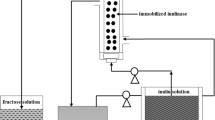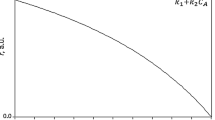Summary
Enzymic conversion of glucose to fructose was carried out in a packed bed and in a fluidized bed reactor. The flow dynamics of these two flow systems, loaded with two different types of immobilized loaded with two different types of immobilized glucose isomerase particles, were studied. The theoretical RTD curve calculated from the axial dispersed plug flow model equation was matched to the experimental RTD curve by an optimization technique. The effect of fluid velocity on the extent of liquid dispersion was established. Theoretical predictions on the conversion of glucose to fructose were calculated using three mathematical models, namely, a plug flow model, a continuous stirred tank reactor (CSTR) model and an axial dispersed plug flow model. The experimental results showed that the axial dispersed plug flow model was superior in predicting the performance of both the packed bed and fluidized bed reactor.
Similar content being viewed by others
Abbreviations
- C θ :
-
Dimensionless concentration
- D :
-
Dispersion coefficient [cm2/sec]
- d p :
-
Mean particle diameter [cm]
- E :
-
Enzyme concentration [mol/gm]
- F :
-
Fructose concentration [mol/cm3]
- F e :
-
Equilibrium fructose concentration [mol/cm3]
- G :
-
Glucose concentration [mol/cm3]
- G e :
-
Equílibrium glucose concentration [mol/cm3]
- G o :
-
Initial glucose concentration [mol/cm3]
- Ĝ :
-
Reduced glucose concentration [mol/cm3]
- K :
-
Equilibrium constant
- K mf :
-
Forward reaction rate constant [mol/cm3]
- K mr :
-
Reserve reaction rate constant [mol/cm3]
- K′ m :
-
Rate constant [mol/cm3]
- L :
-
Total length of the reactor bed [cm]
- l :
-
Length [cm]
- Q :
-
Flow rate [cm3/s]
- r :
-
Rate of reaction based on volume of substrate
- u :
-
Superficial liquid velocity [cm/s]
- v :
-
Interstitial liquid velocity [cm/s]
- V :
-
Reactor bed volume [cm3]
- V mf :
-
Forward reaction rate constant [mol/s·g enzyme]
- V mr :
-
Reserve reaction rate constant [mol/s·g enzyme]
- z :
-
Dimensionless distance along the reactor
- ϱ:
-
Density [g/cm2]
References
Cairns EJ, Prausnitz JA (1960) Longitudinal mixing in packed beds. Chem Eng Sci 12:20
Chung SF, Wen CY (1968) Longitudinal dispersion of liquid flowing through fixed and fluidized bed. AIChE Journal 14:857
Lee YY, Wun K, Tsao GT (1974) Kinetics and mass transfer characteristics of glucose isomerase immobilized on porous glass. Paper presented at 77 National Meeting, Pennsylvania, USA (11A)
Levenspiel O (1972) Chemical reaction engineering. John Wiley and Sons, New York
Pitcher WH (1975) Design and operation of immobilized enzyme reactors. In: Messing RA (ed) Immobilized enzyme for industrial reactors. Academic Press, London New York
Weetall and Messing (1970) US Patent 3519538
Wehner JF, Wilhelm RH (1956) Boundary conditions of flow reactor. Chem Eng Sci 6:89
Author information
Authors and Affiliations
Rights and permissions
About this article
Cite this article
Ching, C.B., Ho, Y.Y. Flow dynamics of immobilized enzyme reactors. Appl Microbiol Biotechnol 20, 303–309 (1984). https://doi.org/10.1007/BF00270590
Received:
Issue Date:
DOI: https://doi.org/10.1007/BF00270590




